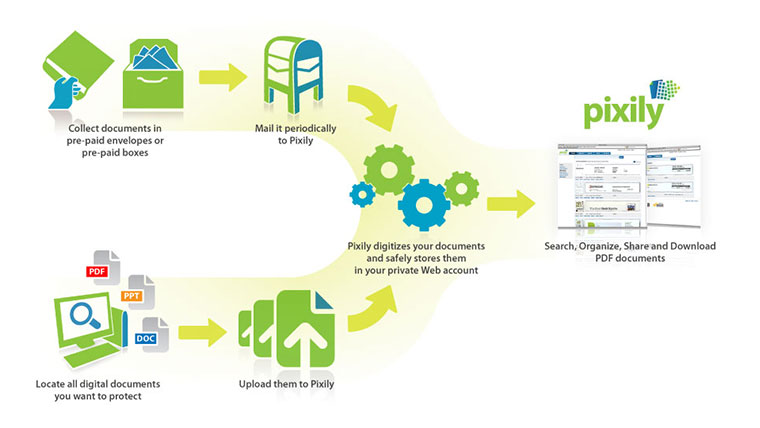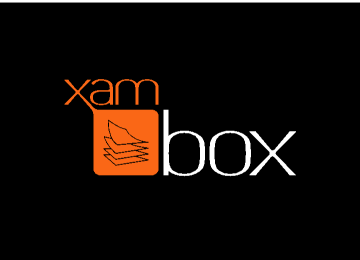The Digital Stars of the NAPO Expo
Last week, we reviewed the paper-based solutions for organizing information and paper displayed at this year’s NAPO annual conference and expo. Today, we start covering the gems of the digital side of the expo–the software, hardware and services that help us live, if not paperless, at least with a bit less paper.
Pixily was the adorably-named star of the expo. Pixily bills itself as an affordable, secure, easy document management service to help individuals and small businesses get more organized and efficient through the magic of pixelating (OK, digitizing) information and transferring it from paper to neatly-ordered, easily-accessed electronic files.

Once in digital form, any data from Grandma’s strudel recipe to illustrations for your patent-pending invention can live securely “in the cloud” of the internet. You can also download anything in your account as a PDF and save it to your own computer or flash drive to ensure you’ll have access whenever…wherever. And, of course, it’s all environmentally friendly.
First, create a Pixily email account: e.g., Paper_Doll@pixilymail.com
Next, choose from four options to get your paper data into the Pixily system:
1. Mail if the idea of hand-scanning your documents is what’s allowed the clutter to pile up in the first place. This method probably saves the most time and effort. Request Pixily’s special “Scanvelopes” via your account; they’re water-and tamper-resistant, pre-paid postage envelopes. Scanvelopes can hold myriad documents, from bills and expense receipts to love notes to your child’s “What I Did Over Summer Vacation” essays.
Skip the staples, smooth the wrinkles, pop in up to 50 sheets and send it via First Class USPS mail. To send documents in bulk, use Pixily’s pre-paid labels (on their boxes or your own) and ship via United Parcel Service. The pre-paid shipping includes return shipping of originals unless you notify Pixily that you don’t want the papers back. Pixily also offers secure shredding services as an option.
Within 3-5 business days of receipt, Pixily’s authorized personnel (right here in the United States) scan and digitize your documents, sending them directly to your private account on Pixily’s secure servers.
2. Upload or Email–If your documents are already in digital form (or once you’ve gotten them that way–see #3), gather them together and send them to Pixily as email attachments or by easily uploading them via Pixily’s website. Pixily supports the following formats: .txt, .html, .pdf., .png, .jpg, .gif and .tif. (M-O-U.S.E. Sorry, but tell me you weren’t humming the Mickey Mouse theme song in your head by that point!) Pixily offers 256-bit encrypted SSL communication, so you can feel secure sending, storing, accessing and retrieving your data.
3. Self Scan–If you aren’t comfy with your documents leaving the house or office, there’s a D-I-Y approach: scan your own documents using your own scanner. Pixily recommends using Fujitsu’s ScanSnap, whose Quick Menu automatically prompts you to select an email address (i.e., your Pixily address!) to which to attach the scanned documents. That’s where option #2 comes in.
4. “Snap it”–It’s a little like Spy vs. Spy, but you can use your camera phone (the system has an iPhone-optimized interface) to snap shots of documents, office whiteboards, etc., and email them directly to your Pixily account.
Once Pixily scans, categorizes and uploads the documents to your account, you or any user whom you authorize can access the files and organize them using Pixily’s digital labeling tools. From there, you can use keyword searches to find the exact documents, and securely share your materials with others.
Pixily offers three pricing plans (Value, Value Plus and Select), starting at just under $15/month for 3000 pages of online storage with one Scanvelope per month.
Pixily seems ideally suited for busy families and small businesses who are long on paper and short on time or resources for getting those documents securely organized in digital form.

ScanDigital was another popular NAPO expo contender. ScanDigital asks:
Yikes, that’s hitting the emotional core, isn’t it? But the truth is that while we all desire our photos to be neatly organized according the rules (in acid-free, lignin-free, archival quality albums or photo boxes), many readers are cringing, knowing that precious memories languish at the bottom of heat- and moisture-exposed cardboard boxes in the garage or attic, in those awful, cellophane-and-adhesive albums that were so popular in the 1980’s, or in closets awaiting us having the time and inclination to start scrapbooking “for real”.
Aging and decay of our photos is a leading source of the “clutter guilt” I encounter as a professional organizer, so it’s not surprising that more and more photo scanning services are marketing to consumers, but ScanDigital has both a 100% Satisfaction Guarantee and keeps all scanned/digitized materials within the United States, which many of their competitors do not.
The steps for getting started with ScanDigital are straightforward. Create an online account and then:
- Select your pricing options: Standard Pricing, at a flat rate per image, or Package Pricing (Starter, Go Digital, Premium or My Life, Digital™), with pricing for blocks of photos/slides/negatives
- Alert ScanDigital whether you’ll be shipping via envelope or box (up to three sizes).
- Select your shipping option (UPS Ground, Next Day Air or 2nd Day Air) or opt to ship the item yourself, at your own cost. For $10, get ScanDigital’s secure DigiPac. Shipped directly to you, DigiPacs include a prepaid return shipping label, secure packaging supplies and detailed instructions.
- Pick your resolution options. For photos, that means “normal quality” (300 dpi for paper photos, or 2000 dpi for slides/negatives) or “highest quality” (600 dpi/paper, 1200 dpi slides/negatives) at an additional 20 cents per scan. For video/film transfer to DVD, the options are for a “premium” digital transfer (suitable for most customers) or “expert” (for professionals).
- Choose your digital storage format (CD, DVD or hard drive).
ScanDigital handles more than photos. They’ll also scan film and negative formats, slides and transparencies, and full photo albums and scrapbooks, as well as film at a price per feet and video (including that long, forgotten standby, BetaMax) at a flat rate per tape.
Assuming you generate a UPS label directly from ScanDigital’s site, you’ll be able to track your materials from your home, through ScanDigital’s departments, and then back to you via their EssentialTracker.
Once ScanDigital gets your items, trained technicians oversee a full process of digital optimization, where they inspect, manually process and quality-review the images, including cropping, rotating and color-correcting, as necessary.
Your originals and the media format you selected are then returned to you, usually within a week, according to ScanDigital. You’ll be able to flip through your originals, enjoy your digitized upgrades and share your free, unlimited online gallery as you desire.
Note: ScanDigital is not inexpensive, and you know that Paper Doll is always price conscious. However, only you can place a price on the value of your time (and memories).

Xambox, from French newcomer Xamance, had an intriguing message to prospective users, based on something they proudly (!) call a chaotic filing system. Indeed, they say:
As shocking as such a statement was to Paper Doll, who lives to sort papers, I was compelled to learn more. How in the world could they advise…no, command…users not to sort?

The basis of the Xambox is a Windows- and Mac-compatible compact scanner with an unusual format. You stack your paper documents in any order in the Xambox Professional scanner and press a button. The Xambox then scans the photos, analyzes the content (including full indexing, color detection, and automatic optical character recognition), stores the digital data for integration with your computer…and then archives the original papers in a box.
Yes, a box. Unsorted, in a box.
When you need to access a document, you perform a keyword search and Xambox displays the digital copy of the appropriate document(s) in PDF form. The twist is that Xambox will also indicate exactly where the hard copy is archived. Xambox says that it will then report “Your invoice is located in box #2, 7th page past the green divider!”
Um. OK. On one hand, it’s nifty to think that the system acts as a Fairy Godorganizer to tell you where the original of any scanned document now lives (i.e., in black and orange Xambox boxes, in your hall closet). On the other hand, this flies in the face of the notion that hard copies, if they must be kept, should be organized and sorted so that they may be retrieved logically, by any authorized person, even when the web is down or the electricity is out.
Xambox definitely has some features of which they’ve a right to be proud. Xambox’s data processing accepts papers in sizes ranging from business cards to legal sized and can correct for vertical or horizontal formatting. It has automatic OCR, in both English and French, and automatic digital copy creation of PDFs.
Their searches definitely seem powerful. Full text searches by keywords are offered, in addition to advanced searching via “Booleans, wild cards, fuzzy searches…” (or so Xambox says…Paper Doll feels pretty fuzzy, herself, reading that). Users can also add meta data to documents and create virtual folders.
Xambox also touts “easy access to original papers”, including archiving and optimum storage conditions in durable boxes. While the boxes may be durable, it doesn’t remove the obligation of the user to store the boxes away from moisture, extreme temperatures or “critters”. Storage capacity of each box is 250 pages, and hard copies are separated by bar-coded dividers to make manual searches more convenient.
Paper Doll is always impressed by the magic of scanning, especially when paired with powerful searching and a user-friendly interface, and Xambox has all that and more. But I’m afraid I just can’t get passed the idea of unsorted, boxed hard copies. What do you think?
The NAPO expo was all about technology this year, so we’ll need one more week to finish up our review and talk about Neat, Blis, Collectify, Jibidee, List Plan It and SaveMyPix.com. Until then, feel free to share your thoughts about these services and products in the comments section.




Follow Me